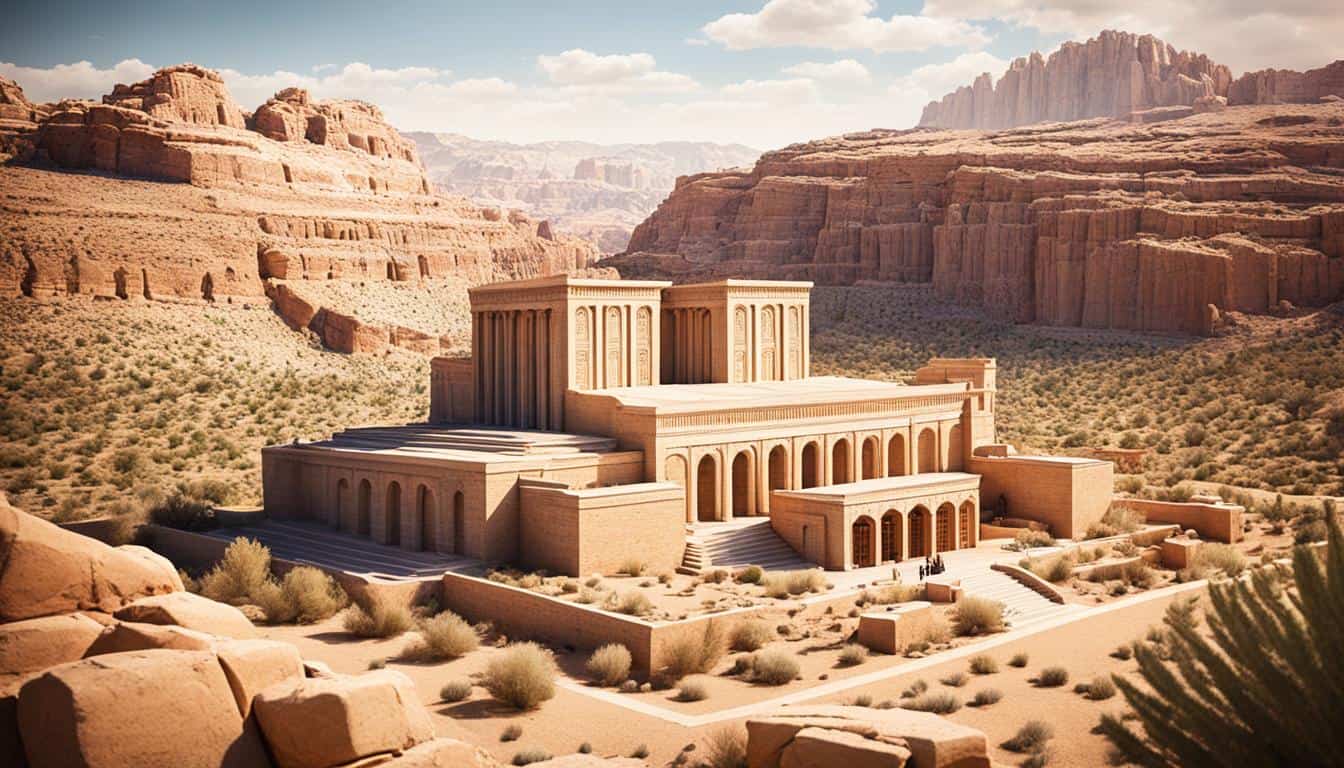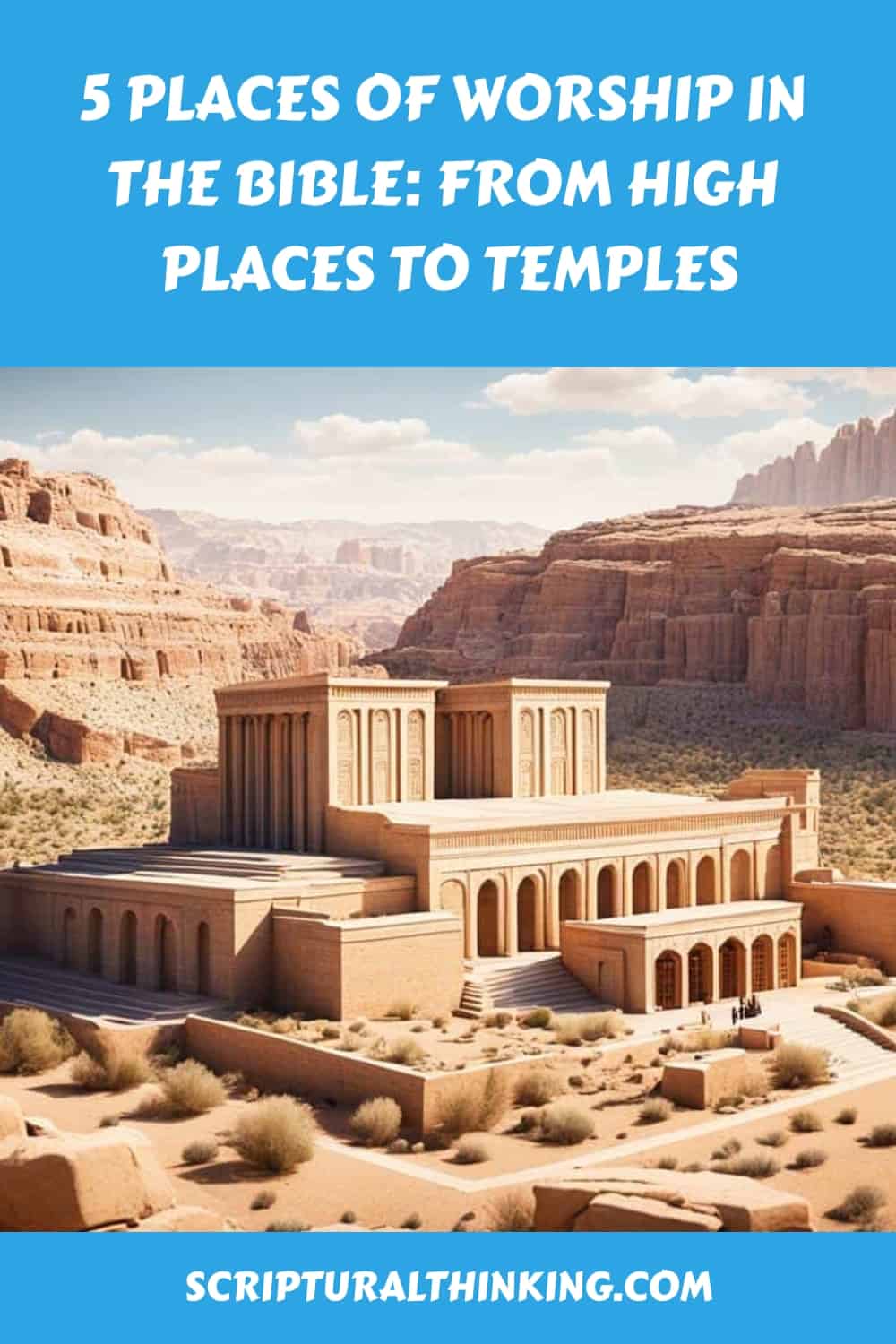Table of Contents
Have you ever wondered where people in biblical times gathered to worship and connect with God? The Bible is filled with stories of sacred locations that hold immense significance for believers. From high places to majestic temples, these places of worship served as powerful symbols of faith and devotion.
But have you ever questioned the importance of these specific locations? Are they simply physical spaces or do they hold deeper spiritual meaning? Explore with us as we dive into the intriguing world of places of worship in the Bible. Discover why climbing Mount Sinai was more than just a physical feat and how high places provoked controversy among believers.
Join us on this journey through time and explore the significance of the Tabernacle, the grandeur of the Temple in Jerusalem, and the sense of community fostered in ancient synagogues. As we unravel the stories behind these places, you’ll find yourself reflecting on your own understanding of worship and the role of physical spaces in your spiritual journey.
So, where did our ancestors worship? Were these places mere conduits for communication with the divine, or did they hold a deeper spiritual significance? Let’s uncover the mysteries of ancient places of worship in the Bible together.
The Tabernacle: A Traveling Tent of Meeting
The Tabernacle played a profound role in the lives of the Israelites during their journey through the wilderness. It served as a portable sanctuary, symbolizing God’s presence among them. This sacred space was meticulously constructed and upheld the importance of communion and worship.
Picture this: the Tabernacle, a grand tent meticulously set up whenever the Israelites relocated. It required great effort and attention to detail to reconstruct this divine dwelling at each new location. Every stitch, every beam, and every piece of furniture held a deeper meaning, all in pursuit of connecting with God.
This image showcases the intricate design and grandeur of the Tabernacle, capturing its awe-inspiring beauty and significance in the biblical narrative. Consider how the Israelites cherished this portable dwelling and the message it conveyed – that no matter where they went, God’s presence traveled with them.
Within the Tabernacle’s inner chambers, the Ark of the Covenant, adorned with golden cherubim, symbolized the presence of God Himself. This sacred space acted as a conduit for communication and worship, where the Israelites sought solace and guidance.
“And let them make me a sanctuary, that I may dwell in their midst.”
– Exodus 25:8 (ESV)
The construction and maintenance of the Tabernacle showcased the Israelites’ devotion and commitment to being in God’s presence. It exemplified the significance of creating a physical space where believers could gather, offer sacrifices, and seek divine interaction.
The Structure of the Tabernacle
To truly comprehend the magnificence of the Tabernacle, let’s explore its structure and layout:
| Area | Description |
|---|---|
| The Outer Court | This open-air area housed the Bronze Altar and the Bronze Laver. Here, the Israelites would bring their offerings and cleanse themselves before entering the Tabernacle. |
| The Holy Place | Separated by a beautifully crafted veil, the Holy Place held the Golden Lampstand, the Table of Showbread, and the Golden Altar of Incense. Only the priests were allowed to enter this sacred space. |
| The Holy of Holies | Concealed behind another veil, this innermost chamber housed the Ark of the Covenant, covered by the Ark’s lid known as the Mercy Seat. The High Priest could enter this holy space only once a year, on the Day of Atonement. |
Each component of the Tabernacle had specific purposes, meticulously designed to facilitate encounters with God and provide a sense of His presence. From the detailed artwork to the careful arrangement of furniture, every element contributed to the overall holiness of the Tabernacle.
The Tabernacle in the Bible reveals the desire of the Israelites to stay connected to God, even amidst their nomadic lifestyle. It serves as a profound reminder that, regardless of our surroundings, we can construct moments of sanctity and meaning in our own lives.
Mount Sinai: Where the Sky Lit Up
Mount Sinai holds a significant place in biblical history. It is the very mountain where Moses, the revered prophet, received the Ten Commandments directly from God. This monumental event forever engraved Mount Sinai’s name in the annals of religious significance.
Imagine standing at the foot of this awe-inspiring mountain. The atmosphere was charged with an ethereal energy as smoke, fire, and thunder engulfed the summit, creating a powerful visual manifestation of God’s presence. The sheer magnitude of this divine revelation left a lasting impression on all who witnessed it.
Climbing Mount Sinai was not a mere physical journey; it symbolized the effort and dedication required to draw nearer to the divine. As Moses took each step closer to the peak, he was ascending not just in altitude but also in spiritual proximity to God Himself.
Mount Sinai’s sacredness resonates with believers worldwide. It serves as a reminder of the reverence and commitment necessary to seek God’s wisdom and guidance. The divine revelations at Mount Sinai continue to inspire individuals to pursue a deeper connection with the divine and live according to the principles set forth in the Ten Commandments.

May we all strive to climb our own personal Mount Sinai, seeking enlightenment and striving to live by the timeless wisdom revealed on that majestic peak.
The Temple in Jerusalem: A Majestic House of Worship
King Solomon’s Temple in Jerusalem was a magnificent structure, adorned with gold and considered the focal point of Jewish worship. People would gather at the temple to offer sacrifices, pray, and celebrate important festivals. The grandeur of the temple demonstrated the significance of communal worship and the devotion of the people.
However, the temple faced destruction and rebuilding, underscoring the idea that even the most revered places can face challenging times. Despite its tumultuous history, the temple remained a symbol of spiritual connection and unity for the Jewish community.
The Significance of King Solomon’s Temple
King Solomon’s Temple, also known as the First Temple, was constructed during the reign of King Solomon around the 10th century BCE. It was a magnificent feat of engineering and craftsmanship, capturing the awe and reverence of worshippers.
The temple served as the dwelling place of God on earth, a sacred space where the divine presence was believed to reside. Its stunning architecture and intricate details were a testament to the artistic talents of the people and their commitment to honoring God.
| Key Features of King Solomon’s Temple | Symbolic Meaning |
|---|---|
| Adorned with gold and precious stones | Symbolized the richness and magnificence of God’s presence |
| Separate inner sanctum called the Holy of Holies | Represented the most sacred space where God’s presence was believed to dwell |
| Various chambers and courts for worship and rituals | Provided designated spaces for different aspects of Jewish worship |
| Continual sacrifices and offerings | Expressed devotion and submission to God |
“I was glad when they said unto me, ‘Let us go into the house of the Lord.’ “
The Destruction and Reconstruction
Despite its splendor, King Solomon’s Temple faced destruction multiple times throughout history. The first major destruction occurred in 587 BCE when the Babylonians conquered Jerusalem and razed the temple to the ground. The Jewish people were exiled, and the temple lay in ruins for several decades.
However, after the Babylonian exile, the temple was rebuilt under the leadership of Ezra and Nehemiah. The Second Temple, as it came to be known, stood for several centuries before facing destruction yet again, this time at the hands of the Romans in 70 CE.
The destruction of the temple marked a profound shift in Jewish worship practices, as it shifted the focus from centralized worship to decentralized worship in synagogues. Nevertheless, the memory of the magnificent temple in Jerusalem still holds great significance in Jewish culture and history.
The temple in Jerusalem serves as a reminder that even the most revered places can face challenges, yet the devotion and faith of the worshippers endure, regardless of physical structures.
High Places: The Outdoor Worship Spots
Before the construction of formal worship spaces, people in biblical times would seek divine connection by worshiping on high places. These elevated locations, such as hilltops and mountains, were believed to bring them closer to God.
The concept behind worship on high places was rooted in the belief that being physically higher would facilitate a direct connection with the divine. Standing on these high places provided a sense of awe and reverence, creating a sacred atmosphere for worship and communion.
However, the practice of worshiping on high places was not without controversy. While some rituals performed on high places aligned with God’s desires, others deviated from the true essence of worship. The Bible portrays instances where the worship on high places involved idolatry and pagan practices, which were strongly condemned.
“You shall not worship the Lord your God in that way, for every abominable thing that the Lord hates they have done for their gods, for they even burn their sons and their daughters in the fire to their gods.”
(Deuteronomy 12:31)
This serves as a reminder that the physical location of worship is not the sole determinant of achieving a true spiritual connection with God. True worship is characterized by righteousness, obedience, and a genuine heart.
The Significance of Worship on High Places
Although there were controversies surrounding worship on high places, it is important to acknowledge the significance of these outdoor worship spots. They allowed people to escape the confines of daily life and experience the grandeur of nature while seeking divine guidance and solace.
The practice of worshiping on high places also symbolized the spiritual ascent and the desire to draw nearer to God. It required effort and dedication to climb the elevated locations, mirroring the commitment required to pursue a genuine relationship with the divine.
Moreover, the encounters that took place on high places often resulted in profound revelations and divine interventions. These significant moments strengthened the faith of believers and served as reminders of God’s power and presence in their lives.
The Role of High Places in the Bible
Throughout the Bible, numerous notable events occurred on high places. Here are some examples:
- Moses received the Ten Commandments on Mount Sinai, a high mountain shrouded in smoke and fire.
- Elijah confronted the prophets of Baal on Mount Carmel, demonstrating the power of the one true God.
- David and Solomon built altars and offered sacrifices on high places to worship and seek God’s guidance.
These instances highlight the historical and spiritual significance attributed to high places in the Bible. They were sites of encounter, revelation, and worship, shaping the faith and experiences of those who sought God in such elevated spaces.
The Versatility and Controversy of High Places in Worship
While worship on high places holds a significant place in biblical history, its practice evolved over time. In later periods, God designated specific locations for worship, emphasizing the importance of proper worship practices and discouraging the idolatrous practices associated with high places.
Ultimately, the controversies surrounding high places in the Bible exemplify the struggle to maintain the purity of worship amidst cultural influences and human tendencies. It serves as a constant reminder that genuine worship requires aligning our hearts, intentions, and actions with God’s desires.
In the next section, we will explore another significant place of worship in the Bible: synagogues, the local meeting spots where the Jewish community gathered to pray, learn, and find solace in times of spiritual need.

| High Places in the Bible | Significance |
|---|---|
| Mount Sinai | Revelation of the Ten Commandments |
| Mount Carmel | Elijah’s confrontation with the prophets of Baal |
| Altars built by David and Solomon | Offerings and worship to seek God’s guidance |
What is the significance of the Houses of Prophets in relation to the Places of Worship mentioned in the Bible?
In the Bible, there are six biblical prophet homes that hold significant importance in relation to the Places of Worship. These houses were where the prophets lived and received divine messages, making them significant spiritual centers. They serve as reminders of the deep connection between the prophets and the places of worship.
Synagogues: The Local Meeting Spots
In biblical times, synagogues played a crucial role as community centers where people would gather for prayer, learning, and socializing when the temple was not accessible. These local meeting spots served as a spiritual hub, fostering a deep sense of belonging and support during challenging times.
Similar to your neighborhood’s clubhouse, synagogues were places where friends and neighbors came together, prioritizing spiritual practices and communal connection. They provided a space for people to strengthen their faith, seek guidance, and engage in meaningful conversations.
Community gathering in synagogues not only promoted religious teachings but also brought people of different backgrounds and experiences together. It offered an opportunity for knowledge sharing, creating a vibrant atmosphere of intellectual curiosity and personal growth.






